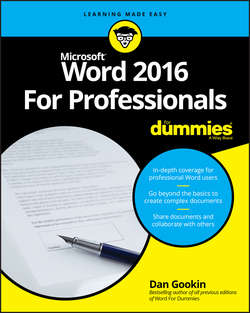Читать книгу Word 2016 For Professionals For Dummies - Dan Gookin - Страница 13
На сайте Литреса книга снята с продажи.
Part 1
Fancy Formatting and Froufrou
Chapter 2
Paragraph Layout
Hyphenation
ОглавлениеThanks to proportional typefaces, and Word’s capability to adjust spacing between words, rarely do you think about hyphenation. You can still hyphenate a long word, splitting it between two lines, and readers will understand and accept. Often it’s better to hyphenate a word than to keep the word intact and destroy any uniformity with a paragraph’s right indentation.
❯❯ Hyphenation is used most often when paragraphs are formatted at full justification. This feature allows for better word and letter spacing within the paragraph.
❯❯ Hyphenation is an optional thing. I recommend using it only when the hyphenated word improves a paragraph’s visual presentation.
Adding a manual hyphen
Word’s Hyphenation feature can check a document and automatically apply hyphens where needed. If you prefer to apply your own hyphenation, then use the hyphen character (–), also called the minus sign. That character splits words at the end of a line, such as the one illustrated in Figure 2-9. See the ugly gap?
FIGURE 2-9: Hyphenating a long word.
To hyphenate the word, follow these steps:
1. Click the mouse to place the insertion pointer at the appropriate spot.
You hyphenate a word between two syllables or double letters. If you don’t know the exact position, refer to a dictionary.
2. Press the – (hyphen) key.
The word is split between two lines, as illustrated in Figure 2-9.
For better results, in Step 2 press Ctrl+(hyphen), the optional hyphen character. Unlike the standard hyphen character, the optional hyphen character vanishes from view when the word doesn’t need to be hyphenated. It’s still in the text, but appears only when needed.
❯❯ To view optional, hidden hyphens, use the Show/Hide command. The optional hyphen character appears as the ¬ symbol. This character is known as a logical negation symbol, which is pronounced “not.”
Automatically hyphenating text
You don’t need to fuss with hyphenation, providing that you activate Word’s Hyphenation feature. When activated, Word automatically inserts the optional hyphen characters in your text as needed.
To activate automatic hyphenation, obey these directions:
1. Click the Layout tab.
2. In the Page Setup group, click the Hyphenation button.
3. From the menu, choose Automatic.
Once active, Word hyphenates all text in the document, as well as new text you type. You may see hyphens added and removed quickly as you work on the text.
If you prefer to review Word’s hyphenation choices, choose Manual in Step 3. You see the Manual Hyphenation dialog box, shown in Figure 2-10. Click to place the hyphen and then click Yes to hyphenate the word. Click No to leave the word unhyphenated.
FIGURE 2-10: The Manual Hyphenation dialog box.
Continue to work the Manual Hyphenation dialog box to hyphenate (or not) the entire document. When hyphenation is complete, click OK.
Manual hyphenation isn’t interactive; it’s done all at once. So, after you choose Manual, the None option is chosen from the Hyphenation menu and automatic hyphenation is disabled.
Inserting an unbreakable hyphen
An unbreakable hyphen prevents Word from splitting text you don’t want split, such as a phone number or a mathematical equation.
To insert the unbreakable hyphen character, press Ctrl+Shift+(hyphen). It looks like a regular hyphen, but Word won’t split the text between two lines.
Just as you can insert an unbreakable hyphen, you can also insert a nonbreaking space when you don’t want words split between two lines. The nonbreaking space character keyboard shortcut is Ctrl+Shift+spacebar.
